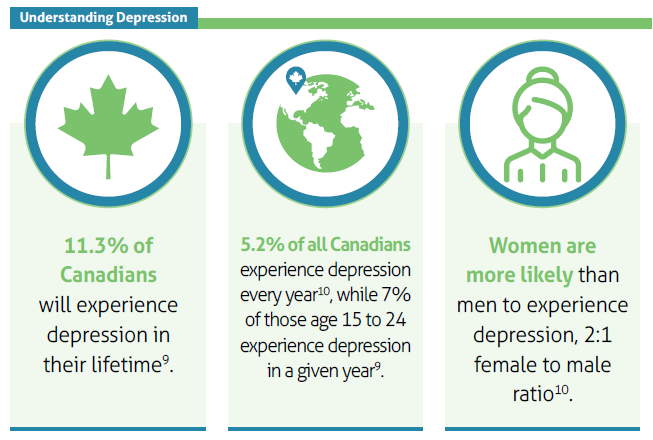
Everybody goes through ups and downs in their lives, but normal life experiences shouldn’t be confused with the serious mental disorder known as Depression. One of the most common mood disorders, depression can have serious and lasting implications on an individual's mental and physical health. (e.g. increased aches and pains, chronic fatigue, heart disease, etc.).
A study in 2012 by Canadian Community Health Survey (CCHS) on Mental Health identified that 5.2% of Canadians over the age of 15 reported having had a depression in the last 12 months. The same study also identified that 11.3% of all Canadians will experience depression in their lifetime.1
Although the number of people suffering from depression continues to rise, there are misconceptions between sadness and depression. In this edition, we will identify what depression is, symptoms of the depression, and how to manage those symptoms.
The Differences Between Sadness and Depression
Sadness is a normal human emotion we all experience, often triggered by difficult, challenging, hurtful, or disappointing experiences or situations. Sadness is typically linked to a specific event or scenario; we experience sadness about something.
This means when that ‘something’ changes, our emotional well-being improves and returns to our pre-event state.2
Depression, on the other hand, is a mental disorder which makes individuals feel sad or indifferent to many events or scenarios. There may be no specific trigger, situation, loss, or change that causes the depressive symptoms, just an overwhelming and perpetual state of unhappiness.2
Signs of Depression
Those who suffer from depression see and experience life differently than other individuals. Depression can drastically impact an individual’s energy level, motivation, and ability to experience joy, pleasure, excitement, satisfaction, connection, and meaning.2

It is important to realize that the resiliency of those suffering from depressive disorders is much lower as compared to individuals who are not diagnosed with depression. Depressed persons often reach states of anger or frustration faster over the same experiences compared to their counterparts. They are also more likely to break down emotionally and take longer to recuperate from those experiences.2
If someone experiences five or more of any of the symptoms below for at least two weeks, then depression may be the cause:3
- Aches or pains, headaches, cramps, or digestive problems without a clear physical cause and/or that don’t ease, even with treatment
- Appetite and/or drastic weight changes
- Decreased energy or fatigue
- Difficulty concentrating, remembering, or making decisions
- Difficulty sleeping, early-morning awakening, or oversleeping
- Feelings of guilt, worthlessness, or helplessness
- Feelings of hopelessness or pessimism
- Feeling restless or having trouble sitting still
- Irritability
- Loss of interest or pleasure in hobbies and activities
- Moving or talking more slowly
- Noticeably depressed
- Persistent sadness, anxiousness, or “empty” mood
- Thoughts of death or suicide, or suicide attempts
How to Manage Depression Symptoms
In addition to medically supervised pharmaceutical treatment, there are many psychological therapies such as Cognitive Behaviour Therapy and support groups that can be helpful.* Here are some non-medical approaches that may improve the symptoms of depression:
Stay active. Studies have shown that 20 to 30 minutes of regular physical activity a day can help to relieve symptoms of mild to moderate depression. Physical activity, releases endorphins, a powerful chemical in the brain that energizes and lifts one’s spirits.4
Practice mindfulness. Being mindful of negative thoughts can help to isolate feelings, and reframe the experience in a constructive manner. Through consistent practice, individuals may recognize negative thoughts, and work to change the way the experience is perceived. Over time this will retrain the brain to think more positively.5
Sleep schedule. Having a regular sleep schedule can help train the body in knowing when it is time to rest and re-energize. Many people with depression often have symptoms of insomnia, which can impact someone’s ability to fall asleep and often worsens depressive symptoms. Staying active and building a sleep routine may help with falling asleep, allowing one to better prepare mentally and physically for tomorrow’s challenges.6
Eat better. Eating foods that are high in vitamins and minerals are known to help regulate serotonin levels which may help to reduce symptoms of depression and mood swings. Here is a list of vitamin rich foods to try:7
- B12 and folate – lentils, almonds, spinach, chicken, fish
- Omega-3 fatty acids – haddock, salmon, nut oils, algae, cod
- Selenium – cod, brazil nuts, walnuts, poultry
- Vitamin D – bread, milk, breakfast cereals
If you or someone you know may be facing extended periods of depression, seek out professional support from a qualified healthcare professional. They will be able to provide you with a range of options from therapies to medications, or lifestyle approaches to alleviate symptoms of chronic depression.
*Always consult with a physician or qualified health care professional to identify the right course of treatment for depression.
Sources
1. Government of Canada, Public Health Agency of Canada. "Institutional links." What is depression? - Public Health Agency Canada. N.p., 30 Dec. 2016. Web. 14 July 2017. <http://www.phac-aspc.gc.ca/cd-mc/mi-mm/depression-...
2. Winch, G., Dr. (2015, October 02). The Important Difference Between Sadness and Depression. Retrieved July 14, 2017, from https://www.psychologytoday.com/blog/the-squeaky-w...
3. National Institute of Mental Health . (2016). Depression. Retrieved July 14, 2017, from https://www.nimh.nih.gov/health/topics/depression/...
4. Royal College of Psychiatrists. (2014, November). Physical Activity and Mental Health. Retrieved July 14, 2017, from http://www.rcpsych.ac.uk/healthadvice/treatmentswe...
5. Teasdale, John D., J. Mark G. Williams, and Zindel V. Segal. The mindful way workbook: an 8-week program to free yourself from depression and emotional distress. New York: The Guilford Press, 2014. Print.
6. Edlund, Matthew. "Want to Treat Depression? Get People to Sleep." Psychology Today. Sussex Publishers, 21 Nov. 2013. Web. 14 July 2017. <https://www.psychologytoday.com/blog/the-power-res...
7. Gaynor, Mitchell L., M.D. "Diet and Depression." Psychology Today. Sussex Publishers, 25 Oct. 2014. Web. 17 July 2017. <https://www.psychologytoday.com/blog/your-genetic-...
8. Government of Ontario, Ministry of Health and Long-Term Care. "Publications." Depression - Mental Health - Publications - Public Information - MOHLTC. Government of Ontario, Ministry of Health and Long-Term Care, 2017. Web. 17 July 2017. <http://www.health.gov.on.ca/en/public/publications...
9. Canada, Government Of Canada Statistics. "Health Reports Depression and suicidal ideation among Canadians aged 15 to 24Health Reports Depression and suicidal ideation among Canadians aged 15 to 24." Government of Canada, Statistics Canada. N.p., 12 July 2017. Web. 17 July 2017. <http://www.statcan.gc.ca/pub/82-003-x/2017001/arti...
10. Government of Canada, Public Health Agency of Canada. "Institutional links." What is depression? - Public Health Agency Canada. N.p., 30 Dec. 2016. Web. 17 July 2017. <http://www.phac-aspc.gc.ca/cd-mc/mi-mm/depression-...




